Take a peek into the world of French coffee culture, and dive into the quaint charm of the French coffee bowl.
This isn’t just about the act of drinking coffee; it’s about a rich, entrenched tradition, a distinct symbol of France that is as integral to a French morning ritual as a warm baguette and a slice of butter.
- Why does the French Coffee Bowl hold a Special Place in French Culture?
- The Vintage Appeal of French Cafe Au Lait Bowls
- How to Enjoy Breakfast the French Way with Your Coffee Bowl
- Moving Past the Preconceptions: French Coffee Bowl versus the Mug
- Buying Authentic French Coffee Bowls: What You Should Look For
- FAQ
Why does the French Coffee Bowl hold a Special Place in French Culture?
The Uniqueness of French Coffee Culture
France is not just known for its lovely Parisian cafes and the ritzy Café de Flore; it’s known for a unique coffee culture centered around the French coffee bowl.
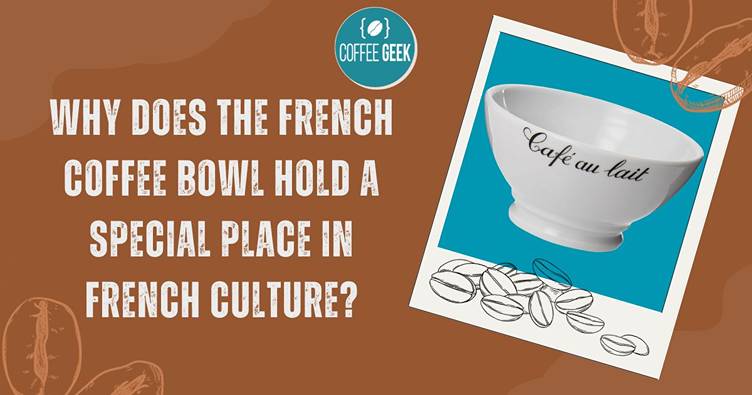
Pouring hot coffee or tea into a bowl the size of a cereal bowl is a quintessential French custom, starkly different from the traditional Italian or other European methods of serving coffee.
It’s more than a way of drinking; it’s a symbol of the relaxed, unhurried French lifestyle that the world admires so.
Understanding the Relevance of the Coffee Bowl in France
Whether you’re in a bustling Paris café or a quiet French kitchen, the sight of a French person cradling a coffee bowl with both hands is commonplace.
The coffee bowl has begun to symbolize comfort, warmth, and familiarity – an expression of French etiquette and joie devivre.
The experience of dipping bread into a bowl of hot tea or coffee is a cherished French breakfast tradition, lending the humble coffee bowl an iconic status in French culture.
Pouring Coffee in Bowls: A Peculiar French Tradition
This peculiar tradition of drinking coffee in a bowl in France is not a modern-day trend but a practice deeply rooted in French history.
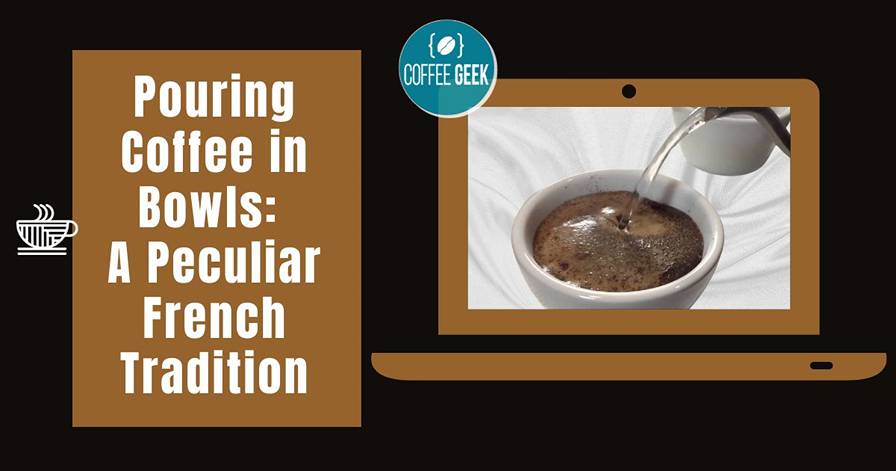
It connects the past and the present, offering a warm blended beverage, the café au lait (coffee with milk), as a daily comforting solace.
No matter if you’re savoring a roasted cup of coffee beans, a milky latte, or a hearty hot chocolate, serving these in a French coffee bowl elevates the simple act of drinking into an intimate ritual.
The Vintage Appeal of French Cafe Au Lait Bowls
Unveiling the History of Vintage French Cafe Au Lait Bowls
Vintage French cafe au lait bowls have a unique history that adds to their charm.
These bowls, made from porcelain, were initially a practical solution for rural French families to drink their café au lait, combining hot coffee and milk as a warm, hearty beginning to their day.
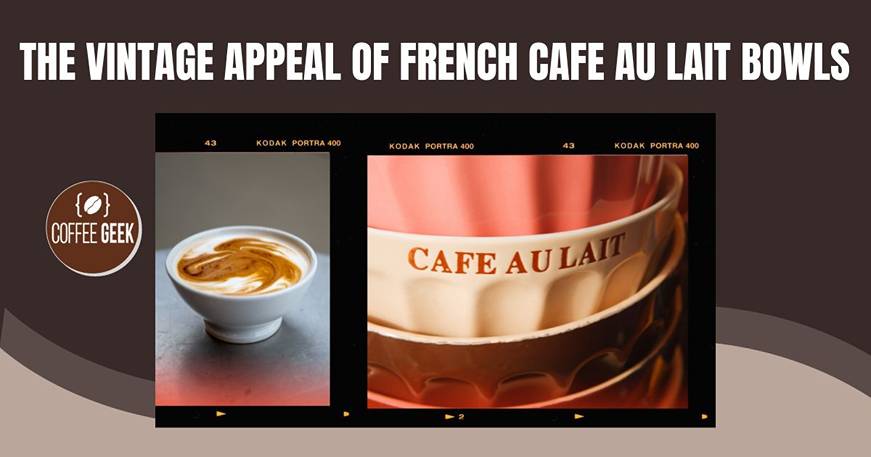
As time passed, these bowls turned from a utility to a collector’s item, representing a tangible piece of French history.
Why Vintage Porcelain Coffee Bowls are Collector’s Items
A vintage porcelain coffee bowl is more than just a French café au lait vessel; it’s a piece of art. Collectors from around the world treasure these bowls, appreciating their age, design, and the stories they encapsulate.
Their historic charm, coupled with the aesthetic appeal, makes them perfect pieces to add authenticity and a hint of French elegance to any kitchen decor.
Terms like ‘bol’ (the French term for bowl), ‘café,’ and ‘au lait’ imprinted on them are like stamps of authenticity, affirming their French origin and allure.
Decorating Your Kitchen with Vintage French Cafe Au Lait Bowls
Adding a vintage French cafe au lait bowl to your kitchen is a simple way to infuse a pinch of Parisian flair into your home.
These porcelain coffee bowls not only serve the intended purpose but can also be used for serving dessert, as a cereal bowl, or even just as decoration.
With their perfect mix of functionality and aesthetics, these bowls are a versatile, stylish addition to any kitchen.
How to Enjoy Breakfast the French Way with Your Coffee Bowl
Dipping Bread in Coffee: A Typical French Breakfast
Imagine a crisp morning in France. You’re at the breakfast table, a hot coffee or tea in a bowl before you, and a fresh baguette by your side. That is where the ritual begins.
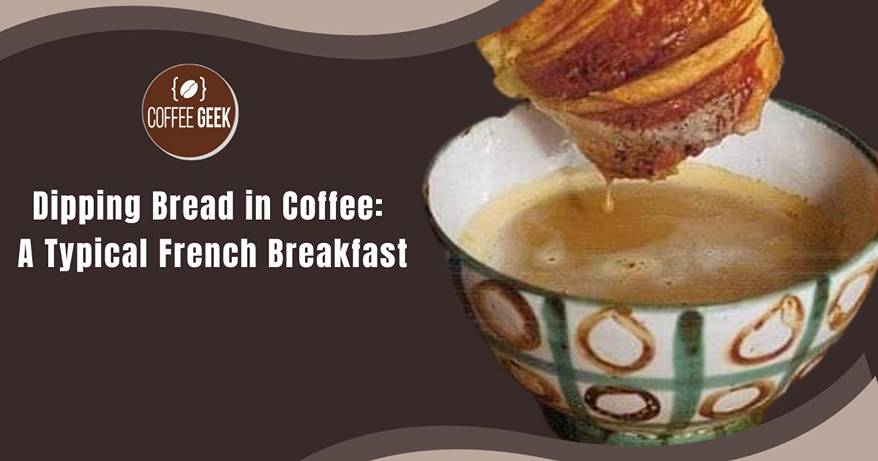
Dipping a piece of bread or a croissant into your beverage might seem unusual to some, but it’s a warm, comforting tradition in French breakfasts, bringing together the best flavors of the morning in every dip.
Au Lait: The Perfect Milk and Coffee Mixture
Café au lait is the perfect blend of equal parts of hot coffee and steamed milk, typically served in a large French coffee bowl.
This classic French drink is the embodiment of the relaxed French morning ritual.
Its calming, creamy taste is sure to start any day off on the right mood.
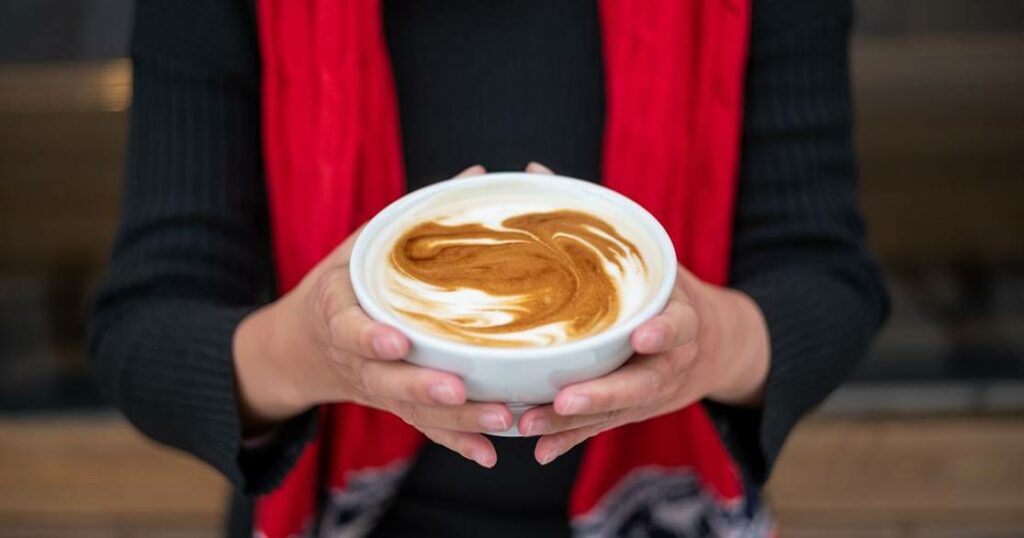
Using French Coffee Bowl for other Breakfast Foods
Beyond coffee, French coffee bowls are versatile additions to a French breakfast.
They can quickly transform into a cereal bowl hosting warm oatmeal, or a container for a portion of delicious French dessert.
The usage of French coffee bowls extends beyond being a beverage holder, representing the versatility of French culture and cuisine.
Moving Past the Preconceptions: French Coffee Bowl versus the Mug
The Differences between a Coffee Cup and a Coffee Bowl
While from a distance, a coffee cup and a coffee bowl may appear similar, up close, the two are quite different.
The most notable difference is in their shape and volume.
A French coffee bowl is typically broader and has a larger capacity than a mug, making it a versatile vessel not just for coffee but also for an array of other breakfast delights.
Why do French People Prefer Bowls to Coffee Cups?
The French coffee bowl isn’t merely a vessel; it’s a lifestyle choice.
The French prefer bowls to cups for numerous reasons – their volume, the comfort of cradling a warm bowl, and the joy of dipping bread into them.
Most importantly, it echoes a quintessential French tradition, a cultural symbol that the French proudly depend on to make their mornings homely and comforting.
Understanding the French Coffee Bowl with Handle
While some vintage French coffee bowls come with a handle, resembling a cup, their broader design and larger capacity distinctly separate them from the traditional coffee cup.
The handle/holder adds an extra ergonomic appeal, enabling one to appreciate the warm beverage within more conveniently.
| Attribute | Description |
|---|---|
| Name | French Coffee Bowl |
| Material | Porcelain, Ceramic, Stoneware, etc. |
| Capacity | Typically 8-12 ounces |
| Design | Wide, shallow bowl with a handle |
| Purpose | Specifically designed for serving coffee |
| Usage | Home, cafes, restaurants |
| Features | Handle for easy grip, often wider than standard cups |
| Colors | Various, including classic white, colorful patterns |
| Maintenance | Dishwasher safe, microwave safe (check manufacturer) |
| Brands | Examples: Pillivuyt, Apilco, Le Creuset, Duralex |
| Origin | Inspired by French cafe culture |
| Price Range | Varies based on material, brand, and design |
| Additional Notes | Some bowls may be part of a matching dinnerware set |
Buying Authentic French Coffee Bowls: What You Should Look For
The Mark of French Porcelain Coffee Bowls
When you’re searching for a true French porcelain coffee bowl, look out for some specific factors. The mark of French porcelain and glass are quality, design, and the distinctive French charm they bring.
The presence of the brand, design details, and even the word ‘bol’ on them validates their French origin, making your purchase more authentic.
A Guide to Selecting Quality Vintage French Cafe Au Lait Bowls
When it comes to selecting vintage French cafe au lait bowls, it’s not just the design you should focus on.
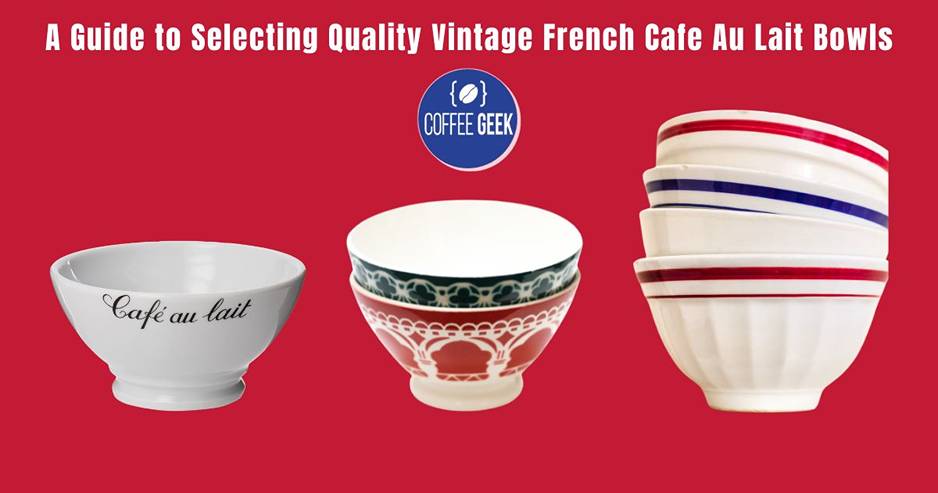
Pay attention to the quality of the porcelain, the condition of the bowl, and the design details that affirm its vintage status.
Be it the classic white bowls or the vibrant ones with floral patterns, each brings a part of French heritage and charm into your kitchen.
Decoding the Appeal of Pillivuyt Coffee Bowls
Among the various brands of French porcelain coffeeware, Pillivuyt holds a prestigious place.
Known for its exceptional quality and classic designs, Pillivuyt coffee bowls are elegant additions to any collection, marking a generous dose of French culture and sophistication to your morning ritual.
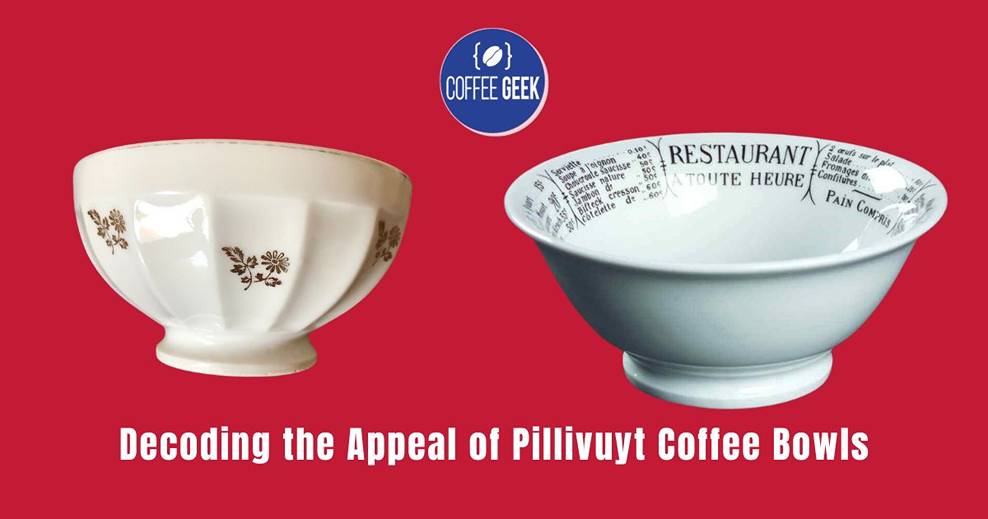
Immerse yourself in the French coffee culture, appreciate the warm feel of a French coffee bowl, savor the delicacy of café au lait, and embrace the French way of life.
There’s a reason why this tradition has endured, and adopting it may just bring a touch of that famed French joie de vivre into your mornings. Bon appétit!
FAQ
What exactly is a café au lait bowl used for in a typical French kitchen?
In a French kitchen, café au lait bowls are typically used for breakfast, bowl at breakfast.
They are a versatile item and can be used not only for drinking tea or coffee, but also for having cereal or any other meal you’d like to use a bowl for.
I’ve seen café au lait bowls while wandering in Paris, share some information about these?
Café au lait bowls have a very traditional French aspect to them. They were first introduced in the south of France, and have since become a common sight in Parisian homes and cafés.
You’ll usually see them used for coffee in France, especially for café au lait, which is just a fancy way of saying coffee with added milk.
They are also often used to dip your croissant or tartine at breakfast, creating a truly French experience.
What is the traditional French tea and coffee service like?
Traditional French tea and coffee service often utilises café au lait bowls instead of a teacup or coffee mug.
It’s not uncommon for people to dip their pastries directly into the bowl of coffee or tea, especially in the privacy of their home.
And don’t confuse this with the Italian style of espresso – the quantities are wildly different!
How does the size of the café au lait bowl compare to a teacup?
The café au lait bowl is noticeably larger than a traditional tea cup. The larger diameter allows for greater versatility in its uses, from coffee to cereal to soup and more.
I am planning to buy some café au lait bowls. What should I look for while assuming?
Keep looking for bowls that can hold the amount of coffee or tea you usually drink. Also, consider the diameter of the bowl because it should be large enough to dip a croissant or another french pastry.
The design is up to your taste, from minimalistic to traditional designs like polka dots.
And don’t assume that a bowl with a foot is just a fancy way of saying a bowl with a pedestal – in fact, a foot can contribute to the overall chic aesthetic of a French kitchen.
How should I order a french drink in a café in Paris?
You can simply ask for “une bol du café au lait” which literally translates to “a bowl of coffee with milk”.
And unlike in the States, in France, there’s no need to specify that your coffee should be hot.
This irritates them. As a bonus, you can also add “a glass of cider” in French by saying “un verre de cidre”.
Where should I keep my café au lait bowls in my kitchen?
You can display them on an open shelf in your kitchen, as they are both functional and can add a chic decor element.
Especially if they’re in traditional french designs like polka dots, they contribute to the overall aesthetic of a French kitchen.
Can I use a café au lait bowl for beverages other than coffee?
Absolutely, café au lait bowls are suitable for a range of beverages, including tea, cider, or even a latte.
They are also perfect for consuming your morning bowl of cereal. It’s not “bol du lait”, but it’s close enough!
How important is a café au lait bowl to real Parisian breakfast experience?
If you want to recreate the Parisian breakfast experience at home, having a café au lait bowl is essential.
Drinking your morning coffee from these bowls while enjoying some freshly toasted tartine is a delightful way to start your day – just like the Parisians do!
I’ve heard about glass café au lait bowls. What are they like?
Glass café au lait bowls give you a chic way to enjoy your coffee while allowing you to see the beautiful layers and color contrast in your coffee.
They can be especially beautiful when used with lattes or drinks with creatively crafted foam.
Whichever material you choose, the café au lait bowl remains a staple in French kitchen decor.

